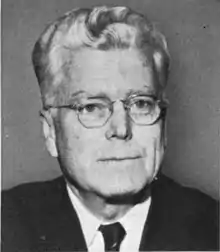Michael A. Feighan
Michael Aloysius Feighan (February 16, 1905 – March 19, 1992) was an American politician from Lakewood, Ohio, near Cleveland. He served as a member of the Ohio House of Representatives, and as a Democratic Party U.S. Representative from 1943 to 1971, serving Ohio's 20th congressional district.
Michael Aloysius Feighan | |
|---|---|
 | |
| Member of the U.S. House of Representatives from Ohio's 20th district | |
| In office January 3, 1943 – January 3, 1971 | |
| Preceded by | Martin L. Sweeney |
| Succeeded by | James V. Stanton |
| Member of the Ohio House of Representatives | |
| In office 1937-1940 | |
| Personal details | |
| Born | February 16, 1905 Lakewood, Ohio |
| Died | March 19, 1992 (aged 87) Washington, D.C. |
| Nationality | American |
| Political party | Democratic |
| Spouse(s) | Florence Feighan |
| Relations | Ed Feighan (nephew) |
| Alma mater | John Carroll University; Harvard Law School |
Originally, he was recruited by national Democrats who wanted to replace Congressman Martin L. Sweeney (D-OH), who had for eleven years held the seat representing the west side of Cleveland. They considered Sweeney to be too isolationist; for example, he had argued against enacting Lend-Lease to the United Kingdom.
After Feighan had served almost three decades in the House of Representatives, some local Democratic officials, led by Cleveland City Council President James V. Stanton, had grown tired of his leadership. Sensing that they could not beat Feighan in one election, they set up a stalking horse running a Michael Sweeney, a local lawyer with a good political name. Sweeney lost, but his vote total showed that Feighan could be vulnerable in a rematch. Two years later, in 1970, Stanton himself ran and defeated Feighan in the Democratic primary, concluding Feighan's political career.
During the legislation of the Immigration and Nationality Act of 1965 Feighan insisted that "family unification" should take priority in immigration policy over "employability", on the premise that such a weighting would maintain the existing ethnic profile of the country. That change instead resulted in chain migration dominating the subsequent patterns of immigration to the United States and consequently a more ethnically diverse population.[1][2]
Electoral history
| Year | Democrat | Votes | Pct | Republican | Votes | Pct | 3rd Party | Party | Votes | Pct | ||||
|---|---|---|---|---|---|---|---|---|---|---|---|---|---|---|
| 1942 | Michael A. Feighan | 34,462 | 61.81% | Harry T. Marshall | 14,001 | 25.11% | Marie R. Sweeney | Independent | 7,289 | 13.07% | ||||
| 1944 | Michael A. Feighan | 75,218 | 75.85% | A. R. McNamara | 23,945 | 24.15% | ||||||||
| 1946 | Michael A. Feighan | 49,670 | 66.99% | Walter E. Obert | 24,476 | 33.01% | ||||||||
| 1948 | Michael A. Feighan | 64,241 | 100% | no candidate | ||||||||||
| 1950 | Michael A. Feighan | 60,565 | 74.21% | Paul W. Cassidy | 21,044 | 25.79% | ||||||||
| 1952 | Michael A. Feighan | 109,211 | 65.21% | John H. Ferguson | 58,271 | 34.79% | ||||||||
| 1954 | Michael A. Feighan | 81,304 | 67.66% | John H. Ferguson | 38,865 | 32.34% | ||||||||
| 1956 | Michael A. Feighan | 105,562 | 65.25% | John H. Ferguson | 56,209 | 34.75% | ||||||||
| 1958 | Michael A. Feighan | 113,200 | 79.43% | Malvern E. Schultz | 29,308 | 20.57% | ||||||||
| 1960 | Michael A. Feighan | 113,302 | 67.79% | Leonard G. Richter | 53,845 | 32.21% | ||||||||
| 1962 | Michael A. Feighan | 91,544 | 71.04% | Leonard G. Richter | 37,325 | 28.96% | ||||||||
| 1964 | Michael A. Feighan | 115,675 | 74.43% | Joseph A. Cipollone | 39,747 | 25.57% | ||||||||
| 1966 | Michael A. Feighan | 63,629 | 76.05% | Clarence E. McLeod | 20,034 | 23.95% | ||||||||
| 1968 | Michael A. Feighan | 72,918 | 72.38% | J. William Petro | 27,827 | 27.62% |
See also
| Wikimedia Commons has media related to Michael A. Feighan. |
References
- Tom Gjelten, Laura Knoy (2016-01-21). NPR's Tom Gjelten on America's Immigration Story (Radio broadcast). The Exchange. New Hampshire Public Radio. Retrieved 2016-06-07.
- Gjelten, Tom (2015-08-12). "Michael Feighan and LBJ". Archived from the original on 2016-05-06. Retrieved 2016-06-07.
- "Election Statistics". Office of the Clerk of the House of Representatives. Archived from the original on 2008-07-30. Retrieved 2008-08-24.
External links
- United States Congress. "Michael A. Feighan (id: F000060)". Biographical Directory of the United States Congress.
- Michael Feighan Papers at the Seeley G. Mudd Manuscript Library, Princeton University
- The Political Graveyard profile
| U.S. House of Representatives | ||
|---|---|---|
| Preceded by Martin L. Sweeney |
Member of the U.S. House of Representatives from Ohio's 20th congressional district 1943 – 1971 |
Succeeded by James V. Stanton |
